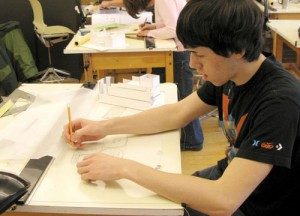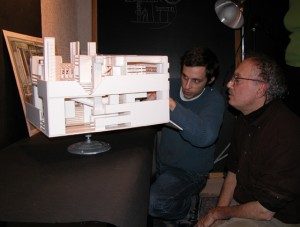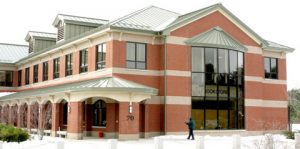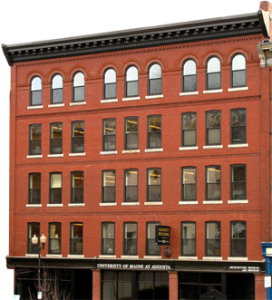A Unique Approach
As a student of Architecture, you’ll learn to analyze the needs of others, translate creative ideas into physical designs, and develop the interpersonal tools to articulate solutions.
UMA’s program is based on the behavioral and conceptual approaches to design, which is often overlooked in other professional or pre-professional curricula.
Our approach perceives an architecturally-designed space as an environmental setting in which the space itself supports and encourages the highest and best satisfaction of the activity for which the space was originally designed. A classroom, for example, can help a student learn and a teacher teach simply by the way it is designed—acoustics, color, textures, and all the other elements.
UMA Architecture’s Mission: Architecture Through Engagement
 The program’s mission is consciously simple and desires to be universal. Our desire is to think beyond the classroom and even beyond architecture. We want to empower YOU, our students, some of which may not become practicing architects, to be good citizens and good stewards of the built environment. Combined with a liberal arts core, we aim to create life-long learners who utilize their education and energy to strengthen their respective communities.
The program’s mission is consciously simple and desires to be universal. Our desire is to think beyond the classroom and even beyond architecture. We want to empower YOU, our students, some of which may not become practicing architects, to be good citizens and good stewards of the built environment. Combined with a liberal arts core, we aim to create life-long learners who utilize their education and energy to strengthen their respective communities.
The vision of the UMA BArch program is to instruct our students to view architecture as a humanistic and professional discipline, which synthesizes art, science, creativity, and math through challenging intellectual rigor. It is an academic search into how the designed environment affects psychological and social behavior while honoring keen aesthetic judgment, and technical understanding of how a building is built with all its many and varied systems.
UMA/ARC achieves this through teaching, scholarship, creative work, research, service to the greater community, and a fully rounded curriculum. The program is committed to the highest ideals of the profession and culture of architecture. UMA/ARC graduates will contribute effectively to the communities in which they live and work, to each other while in school, and to the profession in the future.
Please see our Community Projects to understand the great work our students have been involved with.
We Live In Designed Environments that Enrich Lives
 Because we live and work in designed environments, we must be aware that each space we design influences the experience of activity for which that space was designed. This timeless process goes on with every space we inhabit over time, and even in new spaces that we have just begun to experience. Whether we realize it or not, all spaces affect us socially and psychologically to some extent. The designer must understand that every space he or she designs has that effect on others and design responsibly.
Because we live and work in designed environments, we must be aware that each space we design influences the experience of activity for which that space was designed. This timeless process goes on with every space we inhabit over time, and even in new spaces that we have just begun to experience. Whether we realize it or not, all spaces affect us socially and psychologically to some extent. The designer must understand that every space he or she designs has that effect on others and design responsibly.
The design of space will affect the quality of “activity satisfaction” (the reason for which the space was designed). Part of the design philosophy in our instruction is to make the student aware of his or her vital responsibility to those for whom they design, and to create the highest and best experience and satisfaction of activity.
At UMA/ARC, we strongly believe that space affects life as space affects behavior.
With developed skills in designing effectively, a student designer can conceive and present spaces that enrich the lives of those who use them.
We are committed to Our Core Values
- UMA/ARC is committed to involvement with the greater social and professional community
- UMA/ARC is committed to instill in students the importance and use of Space, Scale, and Light in the design process
- UMA/ARC is committed to hand drawing and physical model making as a means to best understand design technology, and the use of advanced computer programs to present these ideas to others
- UMA/ARC is committed to the investigation and implementation of sustainable ideals
- UMA/ARC is committed to a liberal and fine arts base for architectural education in light of today’s complex society that demands a well-rounded practitioner with knowledge beyond architecture
- UMA/ARC is committed to designing with intention reflecting the awareness that there is a connection between designed space and the quality of the user’s experience, and that designed environments affect behavior
- UMA/ARC is committed to its own academic growth and evolution in maintaining the high standards expected in professional degrees, and to a high standard of student work and faculty instruction toward that end
- UMA/ARC program is committed to the values of mutual respect, cooperation and communication, creativity and innovation, the pursuit of excellence, effective communication, and diversity (please follow this link to review UMA’s DEI policies)
History and Founding Principles of UMA Architecture
The Bachelor of Architecture degree is built upon a solid foundation of UMA Architectural education. Over 25 years ago, Professor Roger Richmond envisioned the architecture program as a two year-plus associate’s degree. At the time he saw a profound need to educate the Maine student in ways of meaningful humanistic design. In UMA, Professor Richmond found a good match for the goals and aims of the architecture curriculum.
 The AA grew to a 4-year Bachelor of Arts degree in 2001. With this growth came the opportunity to review and refocus our overall curriculum. While maintaining high quality core values of Space, Scale, and Light, and the necessity to Design with Intention, we recommitted ourselves to the more advanced tools and language of architecture. Our goal has always been to best prepare our graduates for further study, professional practice, or immediate employment, and to graduate with an awareness of the importance of architecture in the development of society, and architecture’s power to affect the quality of individual lives.
The AA grew to a 4-year Bachelor of Arts degree in 2001. With this growth came the opportunity to review and refocus our overall curriculum. While maintaining high quality core values of Space, Scale, and Light, and the necessity to Design with Intention, we recommitted ourselves to the more advanced tools and language of architecture. Our goal has always been to best prepare our graduates for further study, professional practice, or immediate employment, and to graduate with an awareness of the importance of architecture in the development of society, and architecture’s power to affect the quality of individual lives.
Today these core ideals are the foundation of Maine’s only professional architecture degree. Our program is based on three meaningfully unique parts: Community, Collaboration, and Design. We are seeking committed, creative students to join us in engaging the communities of Maine and beyond.
History, Mission, and Founding Principles of UMA
 In 1965 the 102nd Maine Legislature established the University of Maine at Augusta as a community-based institution offering associate degrees under the auspices of the University of Maine at Orono. In 1971, soon after moving to its present location in Augusta, UMA became an autonomous institution, the seventh campus of the University of Maine System.
In 1965 the 102nd Maine Legislature established the University of Maine at Augusta as a community-based institution offering associate degrees under the auspices of the University of Maine at Orono. In 1971, soon after moving to its present location in Augusta, UMA became an autonomous institution, the seventh campus of the University of Maine System.
Today, as the third largest campus in the University of Maine System, the University of Maine at Augusta offers undergraduate degrees and professional certificates to prepare graduates for the 21st century. Located in Augusta, the state’s capital city, and in Bangor, the University leverages its relationships with state government and communities in central Maine to increase opportunities for students in all programs to be civically engaged, both on campus and in the worldwide “community.” As the institution with the most experience in distance education, UMA continues to be a leader using contemporary technology to provide innovative and quality learning environments for faculty and students.
The University of Maine at Augusta, a regional state university, provides baccalaureate and select associate degrees to meet the educational, economic and cultural needs of Central Maine. Based on a common liberal arts core for all degree programs, UMA delivers professional programs to non-traditional, traditional and place-bound students.
UMA’s Mission: UMA transforms the lives of students of every age and background across the State of Maine and beyond through access to high-quality distance and on-site education, excellence in student support, civic engagement, and professional and liberal arts programs.
A Downtown Presence
331 Water Street, Augusta, Maine
 Since spring 2011, the Architecture Program has been housed in the Handley Hall (formerly the Gannett Building), downtown Augusta. Located at 331 Water Street, our presence in the heart of the state capitol is the ideal place from which our students can engage communities across the state.
Since spring 2011, the Architecture Program has been housed in the Handley Hall (formerly the Gannett Building), downtown Augusta. Located at 331 Water Street, our presence in the heart of the state capitol is the ideal place from which our students can engage communities across the state.
UMA received the Handley Hall in January 2010 as a gift from Richard McGoldrick, a Portland developer who owns a handful of other downtown Augusta properties. Built in 1875, the building was renovated in 2010. The renovations to Handley Hall give the architecture program dedicated studio space, dedicated critique spaces, additional faculty office space, and its first architecturally focused storefront gallery, located at street level.
In addition, Handley Hall provides additional architecture drafting/studio classrooms that are hard-wired with state-of-the-art presentation technology. Additional faculty offices, lobby display areas for student work, meeting space, printing specific areas, computer stations, and a model construction area complete the facility.
Architecture is housed on the second and fourth floors of Handley Hall, with certain Art concentrations working on the third. This new space puts UMA Architecture and our community mission in the community where it can best interact and thrive.
Visit Us
 The UMA Architecture program is located in the newly renovated Handley Hall, 331 Water Street, downtown Augusta. Situated on the Kennebec River, this historic building provides open and collaborative studio and instructional spaces that are filled with natural light.
The UMA Architecture program is located in the newly renovated Handley Hall, 331 Water Street, downtown Augusta. Situated on the Kennebec River, this historic building provides open and collaborative studio and instructional spaces that are filled with natural light.
Given our location, our students find themselves actively participating in the area’s ongoing neighborhood revitalization. Their work, exhibited in our storefront gallery, enlivens the city streets while the community is welcomed to participate in our lectures and engaging events. We would love to show you our new home!
For a tour of our main campus please contact the admission department at umaadm@maine.edu or 207.621.3465.
To meet with an Architecture faculty member please contact Eric Stark, Architecture Program Coordinator at eric.stark@maine.edu or 207.621.3249.
Follow us on Facebook or Instagram.
Sign up for our bi-monthly newsletter here!


